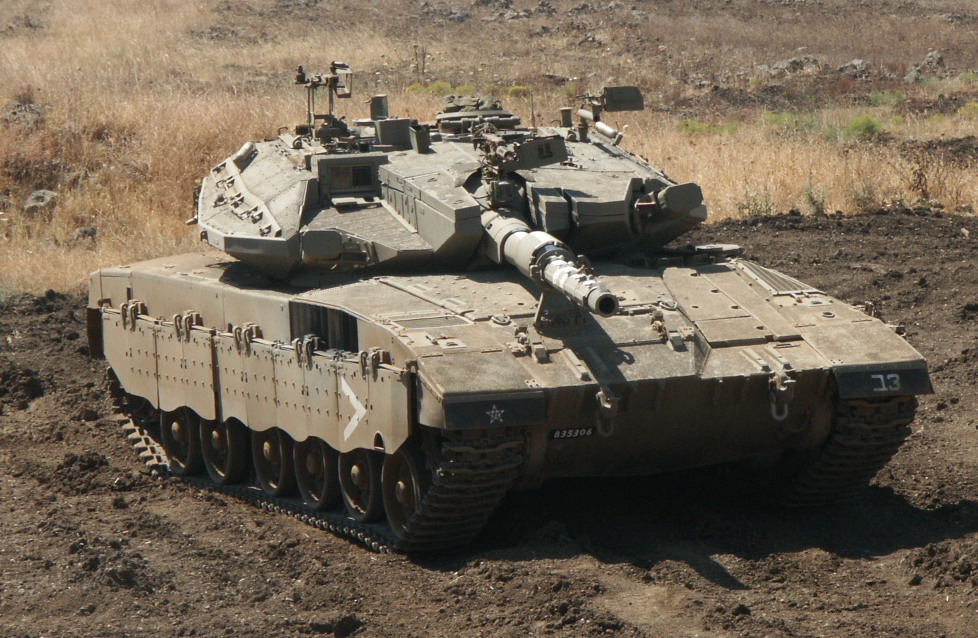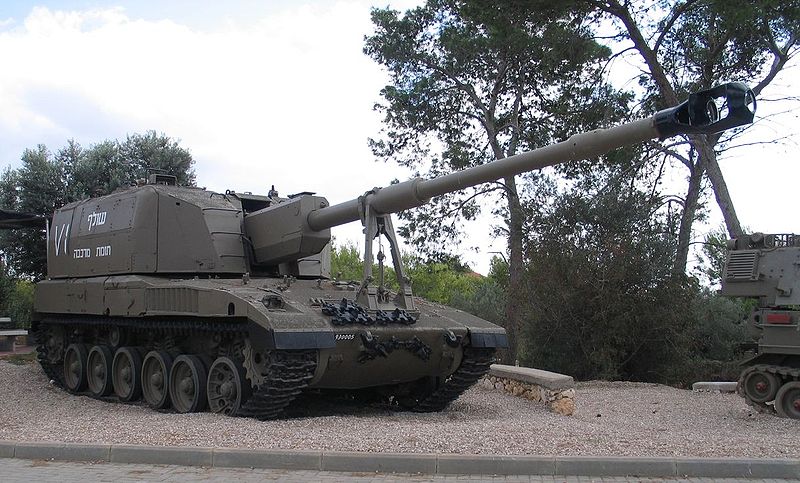
Since the war of 1956, Israel learned how to deal with far superior forces with limited resources and astonished the world with its fast, daring tactics and unexpected victories. The country forged in fifty years, with limited foreign assistance, a powerful, modern defense force. The armored symbol of which is the Merkava, a reference to the ancient war chariots of the days of King Solomon.
The Merkava was designed soon after the Yom Kippur War (1973). The Israelis initially wanted to acquire Chieftains from Great Britain, but the British Government decided in 1969 to cancel any weapon deliveries to Israel, and therefore the project was halted. This prompted the designing of a local tank, which would become the Merkava. The first prototype was ready in 1974, heavily drawing on lessons learned from the 1973 October War. In short, the Merkava was the embodiment of the ideal MBT for Tsahal. Combining speed, endurance, firepower and accuracy with high survivability requirements and an emphasis put on crew protection.
The Merkava Mark II
The Mk. II retained the 105 mm (4.13 in) M68 gun, which was well-proven in 1973. In a general way, the Mk.II was first introduced in April 1983, included from the factory all the improvements learned during the Lebanon war. Emphasis was put on urban warfare and low-intensity conflicts, but general specifications remained unchanged. The new mortar was now completely internal and can fire remotely to avoid exposure of any crew member to small arms fire in a reduced environment. The new, rear part of the turret included an anti-rocket (mostly RPGs) netting and recently discovered “shot traps” were fixed. Protection was made of spaced, rolled homogeneous armor. The transmission was now fully automatic, including a more efficient regime depending on the situation and an increased fuel capacity. The fire control systems (FCS) were given attention, with a general upgrade including meteorological sensors, crosswind analyzers, which all fed the central FCS computer. The electronic sights were also upgraded, with a more finely tuned image amplification and better thermographic optics.
The Mk. II production was more extensive (580), and stopped in 1989. However, the series was upgraded in several steps and remains in service today.
– The Mk. IIB received even more refined thermal optics and many updates to their fire control system
– The Mk. IIC received an increase in armor on the turret top, both for AA protection and in urban warfare, against RPGs fired from building rooftops
– The Mk. IID featured a modular, brand new composite armor (highly classified composition) for easier maintenance and repair.
The Merkava Mk. III

The MkIII was introduced in December 1989 and production ran until 2002, with a total of 780 being produced by MANTAK (Merkava Tank Office), together with no less than 16 subcontractors, locals like IMI (gun and ammo), Urdan Industries (powertrain, transmission and hull), Soltam (mortar), Elta (sensors & optics), Elbit (FCS and electronics), Tadiran (turret and hull internal equipments), El-Op, Elisra and Astronautics (optics, laser warning systems), Rafael Advanced Defense Systems (active protection and remotely operated machine-guns), L-3 Communication Combat Propulsion Systems (main engine and transmission), Urdan (mine-roller/dozer kits) or foreign like Motorola, DuPont, FN Herstal, or Bental Industries in other areas.
This new machine came with two major improvements. The IMI 120 mm (4.72 in) gun, a smoothbore capable of firing upgraded “intelligent” ammunition like the LAHAT ATGM and a much more powerful diesel engine, a license-based MTU turbodiesel giving 1,200 horsepower (890 kW), and a new transmission. The weight rose to 35 tons, but the maximum cruising speed also rose to 60 km/h (37 mph). Another important change was the new turret-driving system, which was now completely independent of the hull, allowing target-focusing while on the move.
During the 90s other improvements were added during production, including an external telephone at the rear for close infantry support, improved and safer ammunition storage containers, laser designators and Kasag modular armor system (Mk. IIIB). The latter was improved in the early 2000s, but as always, details are classified.
The Mark III BAZ (contraction of Barak Zoher) was a set of improvements applied in 1995 on the oldest series, comprising a new composite armor (Mk. IIID), upgraded FCS components and improved tracking system from EL-OP and Elbit Ltd allowing to engage several moving targets while on the move, NBC protection, and a better, locally built air conditioning system.The Mark III Dor Dalet (fourth generation) pioneered improvements which would become standardized with the Mark IV. Introduced in the early 2000s, these comprised new Caterpillar tracks, and the R-OWS system (Rafael Overhead Weapon Station), a remote-controlled turret mounted machine-gun.Contemporary Merkava: The Mk. IV
The Merkava IV, for which development began in 1999, was first revealed in an October publication of Bamachaneh and put into service in 2004. This is the most recent addition to the series and is scheduled also for a scaled-down production. 260 have been delivered as far as 2012, 300 more will probably be added by 2025-2030. They include the modifications previously adopted on the BAZ and Dor Dalet, with the Mk. IIID protection. The first major change came from the gun, the improved MG253, upgraded to fire the latest ammunition types, including the APFDS sabot ammunition. The 12.7 mm (0.5 in) main machine-gun is also improved and fires longer and heavier HE rounds.
The Mk.IV has the latest improvements of modular removable armor so far developed with the Mk.IIID, with the addition of the El-Op Knight Mk.IV fire control system, capable to deal with air threats as well like AT helicopters. Coupled with Elbit BMS (Battle Management System), interaction and awareness of the battlefield are also greatly improved. Protection is increased on vulnerable parts for increasing urban warfare efficiency, including to the turret roof, and the belly, in a “v” shape to cope with landmines and better deflecting the blast.
Ammunition protection was also increased by giving a fireproof individual protection to all rounds and removed for sensitive areas. None is actually stored in the turret. To confuse enemy gunners, heat deflection systems are used, borrowed from the IAI Lavi development program. The Tracks, now of the TSAWS-type have also an improved durability of the harshest terrains. Lately, the MkIV also displayed the Trophy active protection system, which is its latest upgrade. Replacement for the Merkava is not scheduled before 2020.
Variant of the Merkava
The Merkava LIC (Low-Intensity Conflict)
This “kit” was designed for urban warfare, includes a remotely operated 12.7 mm turret. Its optics, exhaust ports and ventilators are protected by a metal mesh. Pole markers with LED tips and a rear camera improve all-angle and night vision for the crew.
The Merkava Tankbulance
The roomy hull with capacity for 6 extra passengers has already been tested for ambulance tasks in combat and led to the modification of some tanks (one for each battalion) especially for this purpose. These are internally modified to carry injured personnel, taken in hands by a small team equipped with stretchers and a life support medical station. The tank remains fully operative at the same time, with the sole disadvantage of carrying less ammunition.

The Merkava IFV Namer
Namer means “Leopard” and is, at the same time, the contracted acronym for Nagmash Merkava, or “APC” Merkava. The turret is removed and the cabin completely revamped to carry 9 infantrymen and their equipment. Armament is comprised of an M2 heavy 50 cal. Mg, a remotely-operated RCWS Mk19 Grenade launcher or the MAG (also remotely operated) 7.62 machine-gun and the usual 60 mm mortar. The Nemmera (Leopardess) is an armored recovery variant. The Sholef is a 155 mm howitzer SPG variant built by Soltam in 1984-86, which remained at prototype stage (2 delivered).
The Merkava in action
As it came into production the Camp David peace treaty seemed to settle the territorial dispute and the lack of immediate threats from Syria, Jordan and Egypt allowed some relief of tensions. But soon the Abu Nidal Organization assassination urged the IDF to invade Southern Lebanon, both to deal with PLO active cells and with Syrian influence over the area. Chieftain and older models then formed the bulk of the armored forces, but the Merkava made its debuts and immediately outperformed theT-62.
The war ended in May 1983 and led Tsahal to increase its tank survivability in urban warfare, but shifted into a border conflict which lasted until 1985, after a progressive withdrawal. Latest modifications proved it was immune to the RPG-7 and, most importantly, to the AT-3 Swagger. Later, they were engaged during the Second Intifada (2002) and the 2006 Lebanon War, dealing with the Hezbollah, now armed with a great array of modern AT equipment (over 1000 missiles were fired at Merkava tanks).
The war left 5 tanks destroyed (two Mk. IV) and 40 damaged, but later salvaged and repaired. The Russian AT-14 “Kornet” proved the most lethal against Mk. II/III models, but Tsahal declared it was satisfied by the Mk. IV performances. The casualty number after tank penetration remained low, an average 2 to 1.5. This was confirmed during the Gaza War, with no casualty so far, mostly the result of revised tactics and better training for asymmetric warfare. Furthermore, since 2010, the Trophy active protection system is being introduced gradually to improve the Mk. IV survivability against the most advanced HEAT missiles, which was proven on March 1st, 2011 near the Gaza border.
Merkava Mk. IV specifications
Dimensions (L-W-H)8.63m (7.45m without gun) x 3.7m x 2.75m
(28’3″ (24’4″) x 12’1″ x 9′ ft.in)
Total weight, battle ready65 tons
Crew4 (driver, commander, gunner, loader) + 6 troops
Propulsion12-cyl 1500 hp (1120 kW) turbocharged diesel
SuspensionHelical SpringTop Speed road/off-road64/55 km/h (40/34 mph).
Operational maximum range500 km at medium speed (310 mi)
Armament120mm (4.7in) SB MG253 with LAHAT ATGM capacity
1xCal.50 (12,7 mm) and 2×7.62mm mod. remote
1x60mm (2.4in ) internal mortar
ArmorClassified composite and sloped design
ProductionAround 500 Mk.IV built as of 2013
Links about the Merkava
The Merkava on Wikipedia
Merkava YouTube video channel
